This report addresses the challenges around the ambitious task of phasing out fossil fuels (oil, gas, & coal) that
are currently used in vehicle Internal Combustion Engine technology (ICE) and for electrical power generation.
A novel bottom-up approach (as opposed to the typical top-down approach) was used to make the calculations
presented here. Previous studies have also tended to focus on estimated costs of production and CO2 footprint
metrics, whereas the present report is based on the physical material requirements. All data, figures and
diagrams have been created or reproduced from publicly available sources and are cited appropriately.
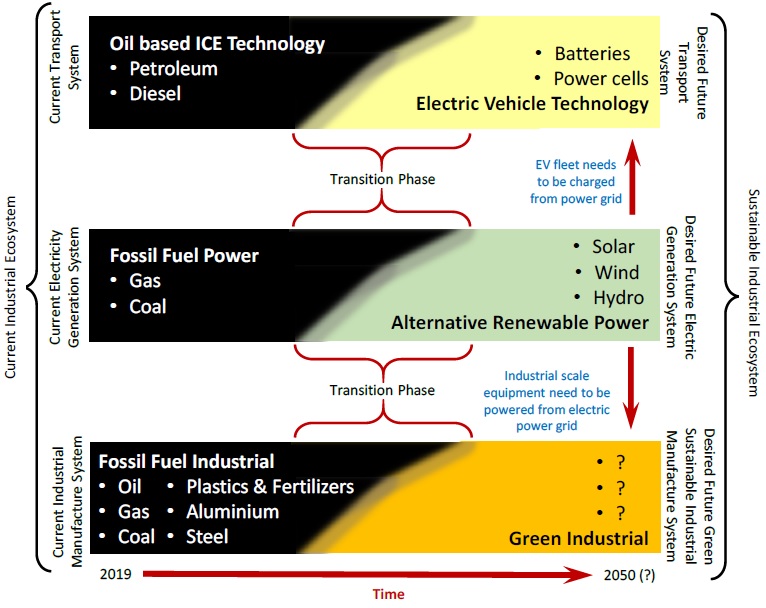
Click the image to enlarge
Taking first the case for replacing all fossil fuel-based vehicles with Electric Vehicle Technology (EVT), it was
believed that in 2019, around 7.2 million EV’s were in use. However, the global fleet of vehicles at the time was
estimated to be 1.416 billion vehicles, suggesting that only 0.51% of the global fleet was currently electric, and
that 99.49% of the global fleet is yet to be replaced. Turning next to the global energy system, data from 2018
estimates that 84.7% was dependent on fossil fuels, whereas renewables (solar, wind, geothermal and biofuels)
accounted for only 4.05% of global energy generation, and nuclear power accounted for 10.1%. This reinforces
the scale of the many challenges we face.
The global strategic decision adopted by most nations to phase out fossil fuels systems and replace them with
renewable energy generation systems is largely driven by CO2 emissions and associated climate change, and not
by dwindling resources, although it is well known that oil, gas and coal reserves are finite. The general plan can
be summarized as follows: ICE vehicles are to be phased out and substituted with Electric Vehicles (EV) and
Hydrogen Fuel cell powered (H2-Cell) vehicles. EV’s are to be powered with lithium ion batteries. Coal- and gas-
fired electrical power generation is to be phased out and substituted with by solar photovoltaic, wind turbine,
hydroelectric, nuclear, geothermal or biowaste to energy power stations.
Knowledge around known mineral resources suggests the raw materials required for the manufacture and
servicing of these renewable technologies will remain truly global in nature. There will not be one nation or
geographic region that can be truly self-sufficient. The focus of this report therefore was to model the viability
of the new global ecosystem using calculations made specifically for the three significant global economies: the
United States (US) economy; the European (EU-28) economy; and the Chinese economy.

Click the image to enlarge
Where possible, all data reported here were sourced for the year 2018. Due to the quarantine restrictions from
the Covid-19 pandemic, 2019 could be the last year of ‘normal’ operation for the global ecosystem. Calculated
models predict future scenarios for the next several decades. This approach acknowledges the typical long start-
up times from exploration through to discovery and starting mineral extraction, which can be anywhere between
10 – 30 years, and that for every 1,000 deposits discovered, only one or two typically actually become viable
mines. It is also in keeping with similarly long manufacturing cycles from invention to commercialization.
Assessment of the Extra Capacity Required of Alternative Energy
Electrical Power Systems to Completely Replace Fossil Fuels
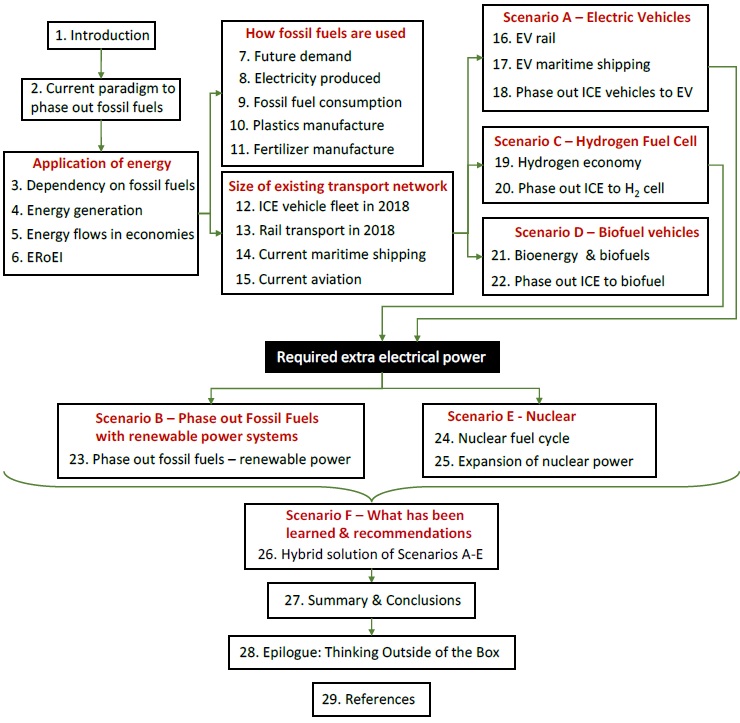
Click the image to enlarge
Calculations reported here suggest that the total additional non-fossil fuel electrical power annual capacity to
be added to the global grid will need to be around 37 670.6 TWh. If the same non-fossil fuel energy mix as that
reported in 2018 is assumed, then this translates into an extra 221 594 new power plants will be needed to be
constructed and commissioned.
To put this in context, the total power plant fleet in 2018 (all types including fossil fuel plants) was only 46 423
stations. This large number reflects the lower Energy Returned on Energy Invested (ERoEI) ratio of renewable
power compared to current fossil fuels.
The number of individual solar panel array farms, wind turbine farms, nuclear power plants, hydroelectric plants
and biowaste to energy plants to deliver this additional power requirement was also calculated. The existing
non-fossil fuel electrical power generation system (9 528.7 TWh) would have to expand by additional capacity,
4 times the existing scope. Each of the modelled non-fossil fuel systems have practical limitations to expansion,
for example it was proposed to develop 16 504 new hydroelectric plants of average size but of course
hydroelectricity can only be sited in very specific geographic conditions, and there may not by sufficient new
sites globally that would be viable.
The first part of the report examines how every developed economy around the World is highly dependent on
fossil fuels, which in turn is linked to industrial activity, economic GDP, food production (the price and quantity
of oil, and oil derived products like petroleum in particular).
The second part of the report quantifies how fossil fuels are used and in what quantities they are consumed.
The calculations were made based around the footprint one full year of operation for the entire industrial
ecosystem, including fossil fuel consumption (oil, gas, & coal), heating, steel manufacture, electricity generation,
number of vehicles in each class, and the distance they travelled.
The third part of the report documents the scale and system size of non-fossil fuel alternatives by examining 6
distinct scenarios, A – F. Scenario A examines the logistics and footprint to phase out petroleum fueled ICE
vehicles and replace them with EV’s. Scenario B builds upon Scenario A, where all other fossil fuel applications
(gas heating of buildings, coal fired steel manufacture and fossil fuel power electricity generation) were
substituted for non-fossil fuel systems. Scenario C examines the viability of a hydrogen-based economy.
Scenario D looks at the viability of biofuels, which have often been referred to as the only truly renewable power
source. Scenario E seeks to establish if the Nuclear Power Plant (NPP) fleet could be expanded fast enough to
an electrical power generation capacity to deliver the needed electricity to power the non-fossil fuel systems
substituting fossil fuel systems. Finally, Scenario F is a hybrid solution based on what was learned from Scenarios
A to E.
In summary, it was found that each non-fossil fuel system has clear advantages and disadvantages when
compared to all other systems. Recommendations are made for when a battery-powered EV should be used
and when a H2-Cell vehicle is the better alternative technology and takes into account the required electrical
power to charge the EV batteries and produce the hydrogen. Biofuels are recommended to fuel a small
proportion of the aviation industry and biomass is recommended to produce bioplastics, replacing a proportion
of the existing plastics industry. Nuclear power can be expanded moderately from the current capacity to
support some industrial operations and heating buildings through winter, especially in the Northern
Hemisphere.
Once the size and scope of the footprint of a non-fossil fuel energy and transport system was developed, it was
compared to existing strategic studies that also examined future targets to phase out fossil fuels. It was found
that previous work has significantly underestimated the number of vehicles to be replaced and supported, and
this impacts the projected numbers for EV’s, batteries and H2-Cell vehicles to be manufactured, which in turn
produces a lower estimate of the size of the required electrical power grid. Hence, the number of required new
power stations estimated in this study is much larger than in any previous report. Also, current policy targets
(for example European Parliament) hope to have 30% of the global energy and transport system to be renewable
by the year 2030. This is only 8.5 years away, and the incubation time for the construction of a new power plant
can range between 2 to 5 years (or 20 years for a nuclear plant).
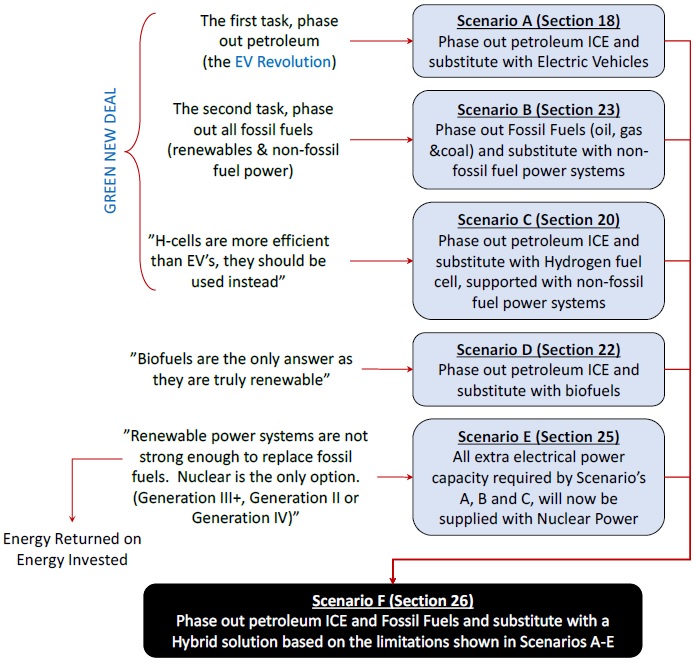
Click the image to enlarge
The mass of lithium ion batteries required to power the 1.39 billion EV’s proposed in Scenario F would be 282.6
million tonnes. Preliminary calculations show that global reserves, let alone global production, may not be
enough to resource the quantity of batteries required. In theory, there are enough global reserves of nickel and
lithium if they were exclusively used just to produce li-Ion batteries for vehicles. To make just one battery for
each vehicle in the global transport fleet (excluding Class 8 HCV trucks), it would require 48.2% of 2018 global
nickel reserves, and 43.8% of global lithium reserves. There is also not enough cobalt in current reserves to meet
this demand and more will need to be discovered. Each of the 1.39 billion lithium ion batteries could only have
a useful working life of 8 to 10 years. So, 8-10 years after manufacture, new replacement batteries will be
required, from either a mined mineral source, or a recycled metal source. This is unlikely to be practical, which
suggests the whole EV battery solution may need to be re-thought and a new solution is developed that is not
so mineral intensive.
Electrical power generated from solar and wind sources are highly intermittent in supply volumes, both across
a 24-hour cycle and in a seasonal context. A power storage buffer is required if these power generation systems
are to be used on a large scale. How large this power buffer needs to be is subject to discussion. A conservative
estimate selected for this report was a 4-week power capacity buffer for solar and wind only to manage the
winter season in the Northern Hemisphere. From Scenario F, the power storage buffer capacity for the global
electrical power system would be 573.4 TWh.
In 2018, pumped storage attached to a hydroelectric power generation system accounted for 98% of existing
power storge capacity. The mass of batteries required is enormous. The estimated mass is 2.78 billion tonnes of
Li-Ion batteries (where stationary power buffer storage makes up most of this). This estimate is so enormous,
it becomes now appropriate to ask is it even possible in context of mineral reserves available, as this
far exceeds global reserves and is not practical. However, it is not clear how this power buffered could be
delivered with an alternative system at this scale. If no alternative system is developed, the wind and solar
power generation may not be able to be scaled up to the proposed global scope.
The chart below shows the approximate metal content portions in a Lithium Ion battery, projected
onto the required 2.78 billion tonnes (there are currently five lithium ion battery chemistries in the
battery market, so this estimation will be an approximation). In theory, there are enough global
reserves of copper if they were exclusively used just to produce li-Ion batteries for just one generation
of vehicles. However, to make just one battery for each vehicle in the global transport fleet (excluding
Class 8 HCV trucks), current global mineral reserves would only be insufficient, where only 21.1% of
nickel, 8.9% of cobalt, 23.3% of lithium and 49.2% of graphite could be delivered. Obviously, more
exploration can be done, but is there enough time to deliver the required volumes?
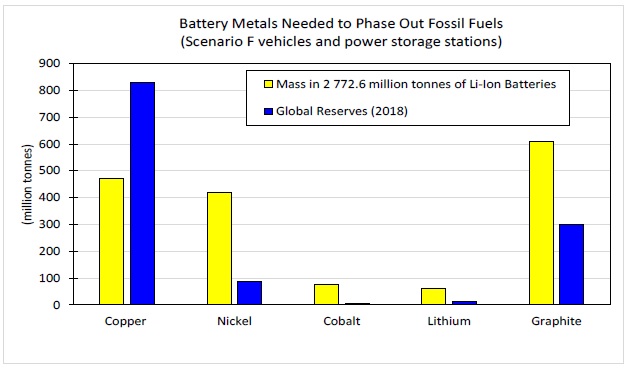
Click the image to enlarge
Current expectations are that global industrial businesses will replace a complex industrial energy ecosystem
that took more than a century to build. The current system was built with the support of the highest calorifically
dense source of energy the world has ever known (oil), in cheap abundant quantities, with easily available credit,
and seemingly unlimited mineral resources. The replacement needs to be done at a time when there is
comparatively very expensive energy, a fragile finance system saturated in debt, not enough minerals, and an
unprecedented world population, embedded in a deteriorating natural environment. Most challenging of all,
this has to be done within a few decades. It is the author’s opinion, based on the new calculations presented
here, that this will likely not go fully to as planned.
In conclusion, this report suggests that replacing the existing fossil fuel powered system (oil, gas, and coal), using
renewable technologies, such as solar panels or wind turbines, will not be possible for the entire global human
population. There is simply just not enough time, nor resources to do this by the current target set by the
World’s most influential nations. What may be required, therefore, is a significant reduction of societal demand
for all resources, of all kinds. This implies a very different social contract and a radically different system of
governance to what is in place today. Inevitably, this leads to the conclusion that the existing renewable energy
sectors and the EV technology systems are merely steppingstones to something else, rather than the final
solution. It is recommended that some thought be given to this and what that something else might be.
Additional Electrical Power Generation Capacity
Required to Completely Phase Out Fossil Fuels
Scenario F- Hybrid Solution (GLOBAL)
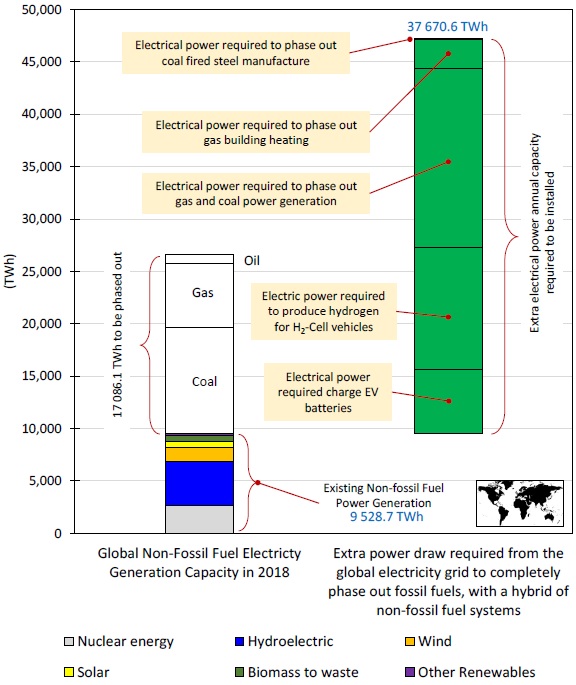
Figure 26.1. The estimated additional electrical power required globally
to phase out fossil fuels, Scenario F hybrid solution (Image: Simon Michaux)
(World Map Image by Clker-Free-Vector-Images from Pixabay)
Click the image to enlarge
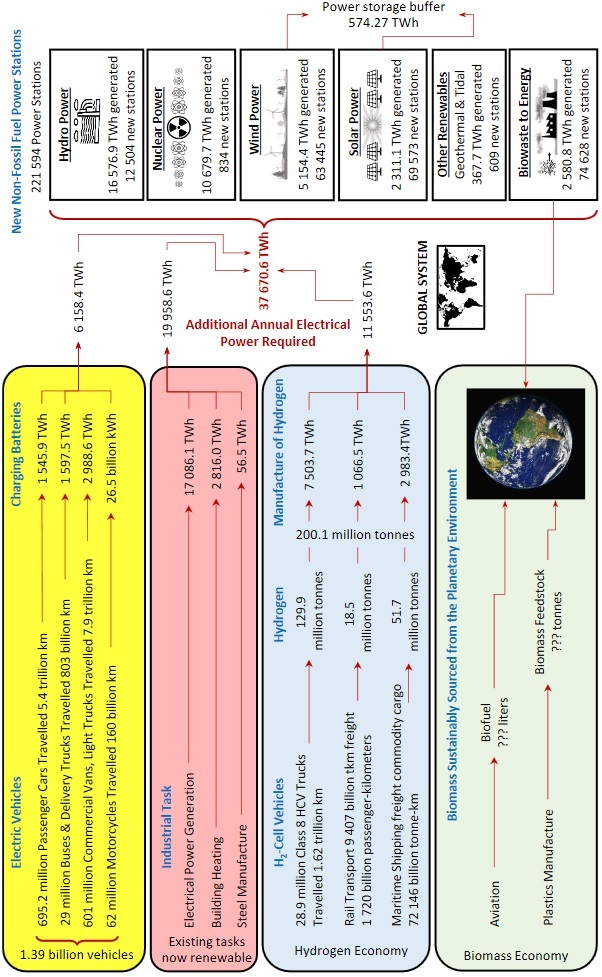
Figure 26.3. Scenario F - Phase out fossil fuel systems GLOBAL footprint
(Image: Simon Michaux) (Planet Earth Image by WikiImages from Pixabay)
(World Map Image by Clker-Free-Vector-Images from Pixabay)
Click the image to enlarge
|
ABOUT THE AUTHOR
Simon Michaux is an Associate Professor in geometallurgy at the Geological Survey of Finland. Work done and research is focused on mineral processing and resource security for the current industrial ecosystem, by examining data patterns in the global mining/minerals/metals industry. The next generation of mineral processing paradigm is being developed at the GTK pilot plant, with the integration of theoretical methods of prediction, empirical methods or measurement and machine learning driven instrumentation. Long term objectives include the development and transformation of the Circular Economy, into a more practical system for the industrial ecosystem to navigate the twin challenges of the scarcity of technology minerals and the transitioning away from fossil fuels. Also, he is working on opening up Europe as a mining frontier to manage minerals supply to resource the incoming renewable energy and electric vehicle network.
|